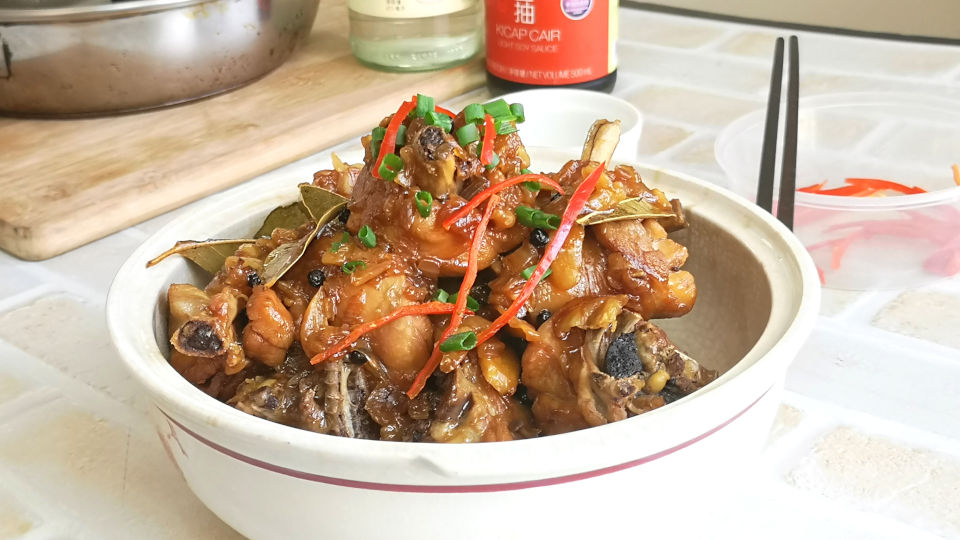Chicken adobo is an ideal dish for those who want to prepare something delicious without spending too much time in the kitchen. It is arguably the most beloved Filipino dish around the globe. The chicken is braised in a mixture of soy sauce and vinegar, infused with bay leaves and various herbs. This recipe has gained immense popularity due to its exquisite flavor and quick preparation time.
Having made this dish a few years ago, I decided to revisit it today, adding a few personal twists. The result was delightful, achieving a perfect balance of saltiness and sourness. This article will guide you through the step-by-step process of preparing chicken adobo in detail.

Note: This post may contain affiliate links. Please read the privacy policy for more information. I may receive commissions for purchases made through links in this post.
Chicken adobo consists of vinegar mixed with soy sauce and garlic. The chicken is marinated and then slow-cooked in this flavorful sauce. While chicken is the traditional meat used, other meats can also be incorporated. Chicken adobo is typically served over rice and enjoyed during everyday meals as well as special occasions.
Adobo is so popular in the Philippines that it has unofficially been called the national dish of the Islands.
How to Cook Chicken Adobo – Step by Step
1. Marinate the Chicken for Better Flavor
You can use any part of the chicken for adobo, but my personal preference is bone-in, skin-on chicken thighs or legs.
The texture of dark meat is preferable, but chicken breast can certainly be used as well. The key difference is that using chicken with bones allows the bones to release additional flavor into the braising liquid during cooking, similar to making chicken stock. This process imparts flavors that you might miss if you opt for breast meat.
Some recipes include chicken bouillon, but this is unnecessary if you are using bone-in chicken pieces. The authentic flavor from the meat far surpasses any artificial flavoring.
Marinate the Chicken Chunks
Marinate the chicken with light soy sauce, white vinegar, sugar, and salt for at least two hours to allow the flavors to penetrate the meat. For even better results, marinating overnight is recommended!
If marinating is not an option, you can still achieve great flavor by braising the chicken for a longer period. Additionally, preparing chicken adobo in advance is beneficial, as it can be stored in the refrigerator for a few days, allowing the chicken to absorb even more flavor from the braising liquid.
The essential seasoning ingredients for chicken adobo are soy sauce and vinegar. You will find that the quantities of these ingredients vary widely among recipes. I typically use 80ml of soy sauce and 40ml of vinegar for one kilogram of chicken. Some prefer a ratio of 60ml of each. Ultimately, it’s about what your taste buds prefer.
I only use light soy sauce for this recipe. Since I pan-fry the chicken before braising, the color is dark enough, making dark soy sauce unnecessary. For vinegar, I prefer rice vinegar, but any white vinegar will work just as well.
As for sugar, while some people opt for brown sugar, I find little difference when using white sugar alone.
2. Pan-Fry the Chicken and Sauté the Aromatics
Pan-frying the chicken before braising adds a depth of flavor due to the Maillard reaction and the caramelization of the sugar. This step creates a taste that cannot be achieved through braising alone.
Next, sauté the crushed garlic until it turns slightly brown. This step enhances the garlic’s aroma compared to adding it directly to the marinade.
Once the garlic begins to brown, add the ginger and diced onion, continuing to sauté until the onion becomes translucent.
3. Braise the Chicken
Afterward, return the pan-fried chicken to the pan. The remaining steps are straightforward:
- Add the remaining ingredients and return the marinade to the pan.
- Braise the chicken over low heat for ten minutes, then flip it over and braise for another ten minutes.
- Cover the pan while braising; there’s no need to add water.
Once finished, perform a final taste test. You can still adjust the saltiness, sourness, and sweetness at this stage. Some prefer a thicker sauce, while others enjoy a more diluted version to drizzle over steamed rice.
Note: If you enjoy braised chicken, consider trying another popular recipe called Three Cups Chicken, which I recently published.
The Origin of Chicken Adobo
The term “adobo” is of Spanish origin, but the dish predates Spanish colonization. Indigenous people had been creating adobo sauce long before the Spaniards arrived.
The cooking method for chicken adobo dates back to the classic period of the Philippines (between 900 and 1500). Unfortunately, the original name of the dish has been lost over time, and even the native population now refers to it as adobo.
The recipe likely originated from the practice of preserving meat with vinegar and salt to extend its shelf life, allowing it to last even without refrigeration. Over time, soy sauce was introduced by the Chinese, eventually becoming part of the adobo sauce.
In the sixteenth century, when the Spanish colonized the Philippines, they discovered this delightful cooking method and decided to name it. The term they chose, adobo, essentially means marinade, although this form of marinating differs significantly from the traditional Spanish “adobo.”

Chicken Adobo: A Versatile Dish
Traditionally, chicken adobo is simmered in a clay pot using the right mixture of vinegar, crushed garlic, soy sauce, bay leaves, and peppercorns. Nowadays, it’s more common to use a metal wok or pan, although some still prefer clay pots over coals.
Variations
Although the basic concept is simple, numerous recipes and variations exist. Many Filipino cooks take pride in their unique methods of preparing the dish. Often, different family members will have their own “tricks” for making a “better” adobo.
Type of vinegar: While vinegar is the main ingredient, the type can vary. In the Philippines, coconut vinegar, cane vinegar, and rice vinegar are commonly used for chicken adobo.
Type of meat: You can substitute pork, beef, or even duck for chicken. There’s also room to adjust the amount of each seasoning ingredient to create your desired flavor profile.
Vegetables: Some recipes incorporate ingredients like potatoes, carrots, and pineapples, showcasing the versatility of this dish!
Furthermore, chicken adobo can be prepared in advance and stored in the refrigerator for several days, making it perfect for parties and picnics.
Different Ways to Cook Chicken Adobo
There is a version of chicken adobo that omits soy sauce, resulting in a lighter color. This variation is often referred to as adobong puti or white adobo, which is considered closer to the original recipe before soy sauce was introduced.
Some cooks opt to include additional ingredients such as hot peppers, red peppers, onions, olive oil, potatoes, or even pineapple. Others may choose to brown the chicken in the oven before serving, deep-fry it, or grill it. The browning process enhances the dish’s flavor.
Regional variations of chicken adobo also exist. For instance, in Zamboanga, Luzon, and Muslim regions, it is common to cook it with coconut milk. In Cavite, mashed pork liver is often added, while in the Laguna region, turmeric gives the dish a vibrant yellow color.
Ingredients
Marinade for the Chicken
Other Ingredients
For Garnish
Instructions
- Marinate the chicken with the marinade ingredients as listed above for at least two hours.
- Heat oil in a wok and sauté the crushed garlic until slightly brown.
- Add onion and ginger until fragrant.
- Add the marinated chicken and brown both sides for about five minutes.
- Pour in the remaining marinade and add some extra water.
- Add the red chili, bay leaves, and black peppercorns.
- Simmer the chicken for about 20 minutes or until the internal temperature reaches 160 degrees Celsius, flipping the chicken for even cooking.
- Season the chicken based on the amount of sauce.
- Once done, remove the chicken from the wok and place it on a serving plate.
- Heat the remaining marinade in the wok until slightly thickened.
- Pour the sauce over the chicken.
- Garnish with spring onions and red chili.
Notes
If you encounter any audio or visual issues while viewing this video, you can find it on YouTube by searching for the title.
Nutrition Information:
Yield: 4 servings
Serving Size: 4 servings
Amount Per Serving:
Calories: 1006
Total Fat: 62g
Saturated Fat: 16g
Trans Fat: 0g
Unsaturated Fat: 38g
Cholesterol: 285mg
Sodium: 3616mg
Carbohydrates: 30g
Fiber: 3g
Sugar: 12g
Protein: 81g
This data was provided and calculated by Nutritionix.

